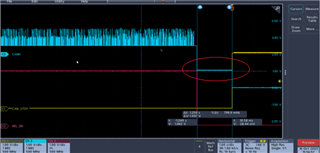Other Parts Discussed in Thread: TCAN1044A-Q1, TCAN1043A-Q1
Hello Concern,
We are measuring the CAN Voltage differently during the CAN Bus Idle Condition-
Ideally, it should be 2.5V (Recessive state),
Condition is - We get a sleep command, after that for ~2 Sec - Bus is in idle State and CAN STBY will become high.
Please check the Attached image for reference.
Question is why CANH is not bias to 2.5V When in bus idle condition.




